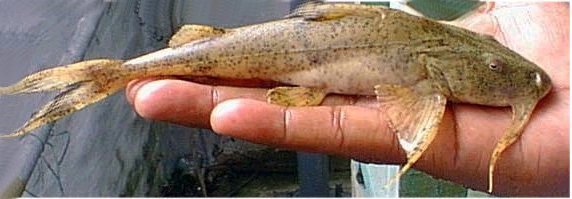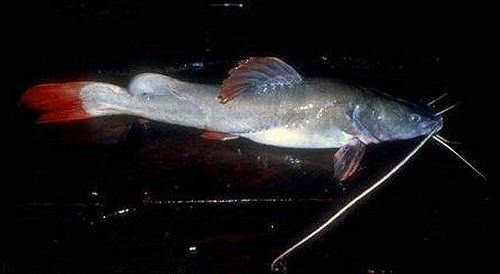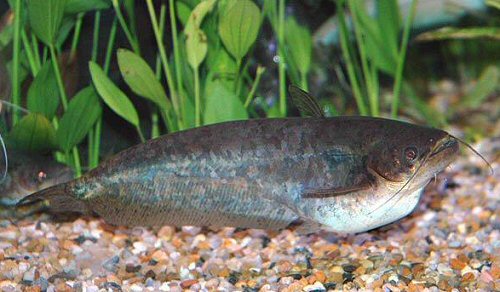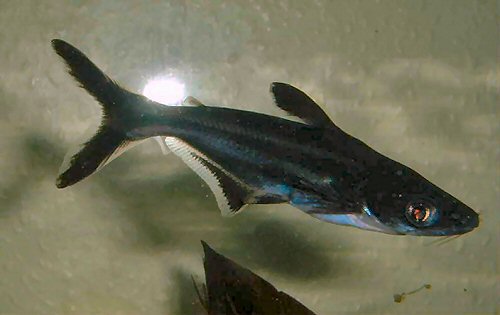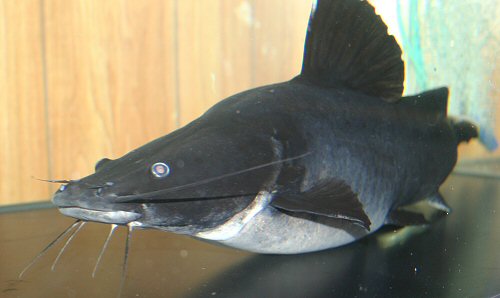SCOTCAT.COM
your internet guide to all things catfish
| Tank Busting Catfish Part Two: The continuing debate, Asian Catfish |
by Chris Ralph |
Bagarius bagarius Hamilton, 1822
Bagarius bagarius is commonly known as the Devil Catfish, which is also referred to as Bagarius yarellii. This catfish is quite a rare find amongst shipments of fish from Asia. Bagarius bagarius belongs to the family Sisoridae which are more commonly referred to as Asian Hillstream Catfishes. Within this group of catfish there are around 23 genera and 85 species. As their family name suggests they are naturally found in the fast flowing freshwaters of southern Asia. Most of the catfish within the family Sisoridae are small to medium in size from 6-30cm, with the exception of Bagarius with representative species growing in excess of 2 metres! Bagarius are described as predatory fish quite unlike the other members of the family Sisoridae which tend to be omnivorous. In its natural habitat Bagarius will live under bogwood or logs in fast flowing rivers in wait of its next victim. All of the Hillstream Catfishes are able to inhabit mountain streams by virtue of the fact that the skin on the undersides of their bodies is adapted by being corrugated thus acting as an adhesive attachment to rocks and stones. In addition to the skin being corrugated or folded another factor making these fish better able to withstand the strong water currents they have flattened heads. It is generally documented that most of the representative species of sisorids have a ventrally positioned mouth, allowing them to rasp algae from the substrate (which is not the case with Bagarius bagarius). I recently had the pleasure of looking after one of these magnificent catfish. I am quite a fan of large catfish as I am sure that those of you who know me appreciate, the problem being the eventual size that this fish can attain…I really could not accommodate a fish that might eventually grow to 200cm (or around 79” in old money). That said I am pleased that I have been able to observe this fish. This fish has evil written all over its face, it watched every move that I made whilst in the fish house and no matter where I was I could sense this fish watching me. It is a fish that does not like to be watched whilst it feeds, so you have to try to be out of eye-shot in order to see it feed. Very much a predator in its natural environment, it will however, take dead foods in captivity. This fish ate almost anything on offer including cockles, whole prawns, mussels, dead fish and large earthworms. It is for this reason that this catfish leads a solitary life, as I would not risk housing any other fish with it. When keeping the Devil Catfish it is essential to provide the fish with oxygen-rich water due to the fact that these fish are from highland streams. I personally found it essential to provide good filtration and water movement in order to keep this fish in optimum condition. Regular 25% water changes are also appreciated by this catfish, and I always carry these changes out weekly and certainly no longer than fortnightly. Other water parameters such as pH and hardness are not as important as good water circulation and aeration, but nevertheless are still of importance. I found that this catfish will tolerate lower water temperatures than most other species of catfish due to the fact that its natural environment is cooler. I kept the Bagarius at around 22ºC. I have to admit that this is a magnificent catfish to observe, but be warned that they will eat anything small enough to fit inside the enormous mouth that they possess. Finally perhaps it is just as well that these fish are rare amongst catfish imports, as in the wrong hands it could do untold damage to other fish and rapidly outgrow small accommodation.
Scientific name: Bagarius bagarius Common
Names: Devil Catfish Natural
Habitat:
India, Burma, Thailand, Vietnam, Sumatra, Borneo
Hardness:
It is documented that juvenile specimens prefer hardness
up to 12ºdGH, but that adult fish can tolerate
a hardness of up to 30ºdGH.
Hemibagrus wyckioides Fang & Chaux, 1949
Asian
Red Tailed Catfish The following week the wholesaler was visited by my friend who informed him of the mix up. The wholesaler said “But you don’t know anything about catfish, and I thought that nobody would notice”, to which my friend replied “I know, but my customer does”! Apparently the wholesaler was a tad embarrassed and has promised to replace the fish for me at some stage (after two years I am still waiting!). I subsequently re-homed one of these catfish to some very good friends on the Isle of Wight, whilst in the remaining catfish has been relocated to one of Daphne’s tanks in her fish room. I have to say that this is a catfish full of character, but one that is also purely evil. It looks at you as if butter would not melt in its mouth, but turn your back and it is probably the most mischievous fish that I have had the pleasure to keep recently. This catfish is constantly rearranging the décor in the tank, one day the aquarium sand (BD Aquarium Sand) is piled up against one end of the tank the next you cannot see through the front glass! This catfish will eat literally anything that I care to feed it ranging from earthworms, cockles, prawns, mussels etc to catfish pellets and floating food sticks. In some respects I will be sad to see the fish go but I know that it will have much larger accommodation than I can provide for it at present. As most of you reading this will realise this catfish is not one to be taken lightly, and is not one for the novice fish keeper. Anyway I digress, back to the confusion over the naming of this catfish. Those of you who surf the web will no doubt have come across many sites listing or referring to our favourite subjects “Catfish”, this is where some of the confusion certainly on my part sets in. My first encounters with this catfish (too many years ago to remember now), were when I saw the odd specimen in a retailers tank labelled up as Mystus nemurus, how things have changed. At one time these catfish were compared to the Red tailed catfish – Phractocephalus hemioliopterus “The Emperor of the Amazon” as being the poor man’s cousin. At the time it was thought that H. wyckioides only grew to around 300mm or 12” how naive we were. As the years have passed by this catfish has seen some name changes from Mystus nemurus to Hemibagrus nemurus (or so we thought), to what we now know as Hemibagrus wyckioides; hence the confusion! To further add to this confusion Hemibagrus nemurus is a valid species but differs from Hemibagrus wyckioides in that it does not posses the red coloured tail and has a more flattened head, shorter adipose fin and filamentous extensions to the dorsal and caudal fin rays. In its natural habitat H. wyckioides is found at irregular depths usually over rocky substrates in large upland rivers. It is documented that this catfish reproduces in its local environment and enters the flooded forest during the high water season which is usually between July and October. This catfish is a predator feeding upon a diet that includes prawns, insects, fish and crabs in its natural habitat. This catfish has the reputation of being one of the most (if not the most) aggressive freshwater fish in the world. This catfish has the ability to bite, hence the reason why in captivity this catfish is ultimately destined to a life in solitary confinement, for if it is kept with other fish the most likely outcome is that they will eventually form part of its diet. As with all large species of catfish (or any other fish for that matter) good water quality and general aquarium husbandry are paramount to the successful keeping of this fish. Water changes should be performed at least weekly to maintain good water quality. This catfish prefers good water movement which can usually be provided by using adequately sized external and or internal power filtration. Finally this catfish is described as being the largest bagrid in Asia reaching weights of up to 80kg!
Family: Bagridae Sub-Family: Bagrinae Description: The base body colour of this catfish is light grey/brown with a greenish tinge. The lower half and underside of the body is whitish in colour. The caudal fin in adult specimens is whole or partially coloured bright red. Juvenile specimens have a whitish coloured caudal fin. The dorsal fin has 1 spine with 7-8 soft rays. The anal fin has 12-14 soft rays. The adipose fin is described as being long with a gently sloping anterior margin. The maxillary barbels usually reach to the middle of the base of the adipose fin, although the barbels sometimes extend beyond this point. The head is described as being flat as opposed to being conical with a short occipital process not close to the basal bone of the dorsal fin. Common
Names(s):
Asian Red Tailed Catfish, Common Baung, Pla Kayeng Thong,
Trey khya, Asian redtail catfish. Natural
Habitat:
Asia: Mekong, Chao Phraya and Xe Bangfai basins; Cambodia,
Thailand river systems, Malay Peninsula, Sumatra, Borneo
and Java.
This particular species can be found widespread throughout Asia in the rivers of Afghanistan to China, Thailand and Borneo. This particular catfish has endangered status in the Western Ghats in India. This particular species of catfish is documented as being found in both freshwater and brackish environments. Ompok bimaculatus naturally occurs in streams and rivers which range in size and flow with currents that can best be described as sluggish to moderate. The rivers are usually quite shallow ranging from 0.5 to 1.5m in depth, and are often muddy and murky. These catfish are also found in canals and inundated fields into which these catfish move during the flood season. They can attain a length of 450mm or 18” standard length. The ideal water parameters for these catfish are pH in the range of 6-8, hardness in the range of 4-28°dGH and temperature in the range of 20-26°C. This is one of the larger species of catfish, and due to the size that it can attain I would not recommend that you keep this catfish in with small fish as they are most likely going to form part of its diet. Also this particular species requires a larger size aquarium and I would suggest a minimum of 72” x 24” x 24” for this species. You are most unlikely to see this catfish amongst importations due to the fact that it is a food fish in the countries in which it naturally occurs. Where offered for sale as a food fish you might encounter Ompok bimaculatus being sold fresh or smoked on skewers! Scientific Name: Ompok bimaculatus Common
Name: Two-spot Glass Catfish, Glass
Catfish or Butter Catfish Size:
450mm SL (standard length is the measurement from the
tip of the snout to the base of the caudal peduncle). Natural Habitat: Widespread throughout Asia in the rivers of Afghanistan to China, Thailand and Borneo. Aquarium Size:
72” x 24” x 24” pH: 6.0-8.0 Hardness:
4-28°dGH Colouration:
The base colour of the body is brown, which is usually
marmorated or blotchy with a conspicuous round black
blotch above and behind the pectoral fin base. The second
of the two spots is at the base of the caudal peduncle
hence the name Ompok bimaculatus!
Pangasius hypophthalmus Steindachner, 1878 (Sauvage, 1878)
Pangasius hypophthalmus is a catfish which should never be imported due to the eventual size that it can attain, and the fact that it is a very nervous and skittish fish, which does not fare well in the confines of cramped aquaria. All too often this catfish is offered for sale as a juvenile fish at around 75-100mm and is quite often labelled as Pangasius sutchi or Iridescent Shark. A couple of years ago whilst on a day out with Kate looking at some aquatic retailers we were horrified to find that this catfish was being offered as the fish of the week on a buy one get one free basis. Needless to say we shall not be venturing back to that retailer. If only these catfish remained small and manageable, but alas they do not. These catfish are bred commercially in large ponds for the aquarium trade, which begs the question why? Obviously there is a demand or else this trade would not exist, how we control the importation of these fish is another story! Who in their right mind would want to keep a catfish that is capable of weighing in excess of 44kg? There is also an albino form of this catfish which is also offered for sale. It is documented that this is a migratory species of catfish moving upstream to spawn in May-July. This fish has been introduced to other countries other than those documented below which include Bangladesh, Philippines, Singapore and Taiwan. Scientific name:
Pangasius hypophthalmus
Hemibagrus wyckii Bleeker, 1858
When providing hiding places they should be firmly positioned within the aquarium and preferably sealed in place with aquarium sealant. Heater guards should also be used in order to protect both the fish and the heater itself from damage. This catfish is very much a predator if ever there was one, and is capable of crushing its prey to almost paper thin proportions with its powerful jaws. I have heard of one crushing the head of a dead Synodontis before swallowing the fish whole! Cover glasses should be firmly in place as this catfish is very powerful swimming from one end of its accommodation to the other at lightning speeds. Scientific
name: Hemibagrus wyckii References: Planet Catfish
- www.planetcatfish.com
|
If you would like to contribute an article, please e-mail me. You will of course be credited for your work.
If you would like to donate any denomination of money to the site just click the above link button. All proceeds will go to running the site and hopefully to keep it going for a few years yet.
Print or e-mail this article below
